Techno-Economic Assessment of an Olive Mill Wastewater (OMWW) Biorefinery in the Context of Circular Bioeconomy
Abstract
1. Introduction
2. Theoretical Background
2.1. Biorefineries
- Platforms, which refer to the intermediates linking feedstocks and final products;
- Products, distinguished as energetic and non-energetic main products;
- Feedstocks, which may be either dedicated (such as grasses, sugar, starch, lignocellulosic or oil-based crops, etc.), or residual (organic, lignocellulosic, oil-based, etc.);
- Processes, which may be mechanical/physical (distillation, filtration, etc.), chemical (oxidation, hydrolysis, etc.), thermochemical (where the feedstock withstands changes in high pressure and temperature, with potential use of catalysts), or biochemical (changes occur under low temperature and pressure, using microorganism or enzymes) processes.
2.2. Olive Mill Wastewater (OMWW)
- −
- Impacts on water bodies: intoxication, discoloration, eutrophication;
- −
- Impacts on soil: changes in fertility, decrease in magnesium, soil porosity;
- −
- Impacts on plants: fruit and leaf abscission, seeds germination, early growing stage.
2.3. Production of PHAs and Biohydrogen
- Biomass products (polysaccharides and proteins), which are biopolymers derived from agro-resources;
- Biotechnology products (polylactides and polyglycolides), which are synthesized from bio-derived polymers;
- Micro-organism products (polyhydroxyalkonates-PHAs), which are micro-organism-based products.
3. Methodology
- RQ1:
- How can the potential of the actual implementation in a specific real-word context of a biorefinery based on novel biotechnologies, which have been developed and tested in vitro, be assessed in a systematic and comprehensive way?
- RQ2:
- How can the derived assessment framework (the answer of RQ1) be used in a specific case-study in a region in Greece, where the planned biorefinery has a feedstock of OMWW and produces PHAs and biogas?
- Relying on the literature, which focuses on the valorization of OMWW in the direction of PHAs and biogas [43,44,45], we present the production process of the facility. The publications mentioned above adopt a bio-engineering perspective and provide evidence on the exploitation of OMWW for bio-polymers and bio-energy production through a combination of both anaerobic and aerobic processes.
- Then, we use the Business Model Canvas [46] to develop the corresponding business model. Business Model Canvas is a tool that provides a detailed structured template for developing and communicating business models, by means of nine elements: value proposition, market/customer segments, (market) channels, customer relationships, key resources/assets, key activities, key partners/collaborators, cost structure, and revenue streams. The importance of novel business models has been underlined in the literature on circular bioeconomy [6,47], while Business Model Canvas has been applied in similar cases of waste valorization in the olive oil sector [48,49].
- In the following step, the economic viability of the planned venture is assessed by examining scenarios of different organizational configurations. In this direction, a techno-economic assessment can provide guidance for valuing the application of a specific technology, OMWW processing in our case. Various approaches to the techno-economic assessment of circular bioeconomic endeavors can be found in the literature [50,51,52]. Our method of analysis is novel, in that it is based on a non-equilibrium system dynamics model calibrated using cost-price data specific to the region of the case study (see below). In addition, such an approach incorporates the endogenous investment dynamics and assesses outcomes in operational—rather than correlational—terms [53].
- Finally, using input from the previous stages, we carry out an analysis of the internal and external environment of the planned facility, based on the strategic management technique of SWOT analysis [54], which is a methodological tool that has already been applied in the context of circular bioeconomy [55,56]. A SWOT analysis can be employed to identify internal and external environmental elements, factors and characteristic, which may act as positive or negative catalysts in the development of a specific venture.
4. Results and Discussion
4.1. The Production Process
- Phase 1:
- Reception and Storage of OMWW
- Phase 2:
- Dilution of OMWW
- Phase 3:
- Anaerobic treatment of OMWW
- Phases 4 and 5:
- Mechanical treatment of OMWW
- Phase 6:
- Aerobic treatment of OSH
- Phase 7:
- Recovery of PHAs
- Phase 8:
- Collection and combustion of biogas
- Phase 9:
- Removal of residuals
4.2. The Business Model
4.3. Techno-Economic Analysis
4.3.1. Simulation-Based Techno-Economic Analysis
4.3.2. Simulations and Analysis
4.4. The SWOT Analysis
5. Conclusions
Author Contributions
Funding
Data Availability Statement
Conflicts of Interest
References
- Carus, M.; Dammer, L. The circular bioeconomy—concepts, opportunities, and limitations. Ind. Biotechnol. 2018, 14, 83–91. [Google Scholar] [CrossRef]
- Giampietro, M. On the circular bioeconomy and decoupling: Implications for sustainable growth. Ecol. Econ. 2019, 162, 143–156. [Google Scholar] [CrossRef]
- Stegmann, P.; Londo, M.; Junginger, M. The circular bioeconomy: Its elements and role in European bioeconomy clusters. Resour. Conserv. Recycl. X 2020, 6, 100029. [Google Scholar] [CrossRef]
- Mouzakitis, Y.; Tsoulfas, G.T. Fostering ‘Bioeconomy Strategy’ through synergies: Managerial implications from Interreg Europe. In the Proceedings of the 2nd International Conference on Management, Economics and Finance (ICMEF), Rotterda, The Netherlands, 15–17 November 2019. [Google Scholar]
- Nizami, A.S.; Rehan, M.; Waqas, M.; Naqvi, M.; Ouda, O.K.; Shahzad, K.; Miandad, R.; Khan, M.Z.; Syamsiro, M.; Ismail, I.M.I.; et al. Waste biorefineries: Enabling circular economies in developing countries. Bioresour. Technol. 2017, 241, 1101–1117. [Google Scholar] [CrossRef]
- Salvador, R.; Puglieri, F.N.; Halog, A.; de Andrade, F.G.; Piekarski, C.M.; Antonio, C. Key aspects for designing business models for a circular bioeconomy. J. Clean. Prod. 2021, 278, 124341. [Google Scholar] [CrossRef]
- de Jong, E.; Higson, A.; Walsh, P.; Wellisch, M. Bio-Based Chemicals: Value Added Products from Biorefineries; Task42 Biorefinery; IEA Bioenergy: Rotorua, New Zealand, 2012. [Google Scholar]
- Mohan, S.V.; Dahiya, S.; Amulya, K.; Katakojwala, R.; Vanitha, T.K. Can circular bioeconomy be fueled by waste biorefineries—A closer look. Bioresour. Technol. Rep. 2019, 7, 100277. [Google Scholar] [CrossRef]
- Cherubini, F. The biorefinery concept: Using biomass instead of oil for producing energy and chemicals. Energy Convers. Manag. 2010, 51, 1412–1421. [Google Scholar] [CrossRef]
- Mohan, S.V.; Nikhil, G.N.; Chiranjeevi, P.; Reddy, C.N.; Rohit, M.V.; Kumar, A.N.; Sarkar, O. Waste biorefinery models towards sustainable circular bioeconomy: Critical review and future perspectives. Bioresour. Technol. 2016, 215, 2–12. [Google Scholar] [CrossRef]
- Liguori, R.; Amore, A.; Faraco, V. Waste valorization by biotechnological conversion into added value products. Appl. Microbiol. Biotechnol. 2013, 97, 6129–6147. [Google Scholar] [CrossRef]
- Maina, S.; Kachrimanidou, V.; Koutinas, A. A roadmap towards a circular and sustainable bioeconomy through waste valorization. Curr. Opin. Green Sustain. Chem. 2017, 8, 18–23. [Google Scholar] [CrossRef]
- Sun, Y.; Wang, T.; Sun, X.; Bai, L.; Han, C.; Zhang, P. The potential of biochar and lignin-based adsorbents for wastewater treatment: Comparison, mechanism, and application—A review. Ind. Crops Prod. 2021, 166, 113473. [Google Scholar] [CrossRef]
- Delisi, R.; Saiano, F.; Pagliaro, M.; Ciriminna, R. Quick assessment of the economic value of olive mill waste water. Chem. Cent. J. 2016, 10, 1–5. [Google Scholar] [CrossRef] [PubMed]
- Foti, P.; Romeo, F.V.; Russo, N.; Pino, A.; Vaccalluzzo, A.; Caggia, C.; Randazzo, C.L. Olive mill wastewater as renewable raw materials to generate high added-value ingredients for agro-food industries. Appl. Sci. 2021, 11, 7511. [Google Scholar] [CrossRef]
- Cherubini, F.; Jungmeier, G.; Wellisch, M.; Willke, T.; Skiadas, I.; Van Ree, R.; de Jong, E. Toward a common classification approach for biorefinery systems. Biofuels Bioprod. Biorefining 2009, 3, 534–546. [Google Scholar] [CrossRef]
- Uihlein, A.; Schebek, L. Environmental impacts of a lignocellulose feedstock biorefinery system: An assessment. Biomass Bioenergy 2009, 33, 793–802. [Google Scholar] [CrossRef]
- International Olive Council. The World of Olive Oil. Available online: https://www.internationaloliveoil.org/the-world-of-olive-oil/ (accessed on 6 October 2022).
- European Commission. Olive Oil. Available online: https://agriculture.ec.europa.eu/system/files/2020-03/factsheet-olive-oil_en_0.pdf (accessed on 6 October 2022).
- Tsagaraki, E.; Lazarides, H.N.; Petrotos, K.B. Olive mill wastewater treatment. In Utilization of By-products and Treatment of Waste in the Food Industry; Springer: Boston, MA, USA, 2007; pp. 133–157. [Google Scholar]
- Justino, C.I.; Pereira, R.; Freitas, A.C.; Rocha-Santos, T.A.; Panteleitchouk, T.S.; Duarte, A.C. Olive oil mill wastewaters before and after treatment: A critical review from the ecotoxicological point of view. Ecotoxicology 2012, 21, 615–629. [Google Scholar] [CrossRef] [PubMed]
- Azbar, N.; Bayram, A.; Filibeli, A.; Muezzinoglu, A.; Sengul, F.; Ozer, A. A review of waste management options in olive oil production. Crit. Rev. Environ. Sci. Technol. 2004, 34, 209–247. [Google Scholar] [CrossRef]
- Niaounakis, M.; Halvadakis, C.P. Olive Processing Waste Management: Literature Review and Patent Survey; Elsevier: Amsterdam, The Netherlands, 2006. [Google Scholar]
- Jeguirim, M.; Chouchène, A.; Réguillon, A.F.; Trouvé, G.; Le Buzit, G. A new valorisation strategy of olive mill wastewater: Impregnation on sawdust and combustion. Resour. Conserv. Recycl. 2012, 59, 4–8. [Google Scholar] [CrossRef]
- Ahmed, P.M.; Fernández, P.M.; Castellanos, L.I.; Pajot, H.F. Exploitation alternatives of olive mill wastewater: Production of value-added compounds useful for industry and agriculture. Biofuel Res. J. 2019, 22, 980–994. [Google Scholar] [CrossRef]
- Vinod, A.; Sanjay, M.R.; Suchart, S.; Jyotishkumar, P. Renewable and sustainable biobased materials: An assessment on biofibers, biofilms, biopolymers and biocomposites. J. Clean. Prod. 2020, 258, 120978. [Google Scholar] [CrossRef]
- Vert, M.; Doi, Y.; Hellwich, K.-H.; Hess, M.; Hodge, P.; Kubisa, P.; Rinaudo, M.; Schué, F. Terminology for biorelated polymers and applications (IUPAC Recommendations 2012). Pure Appl. Chem. 2012, 84, 377–410. [Google Scholar] [CrossRef]
- Chinthapalli, R.; Skoczinski, P.; Carus, M.; Baltus, W.; de Guzman, D.; Käb, H.; Raschka, A.; Ravenstijn, J. Biobased building blocks and polymers—global capacities, production and trends, 2018–2023. Ind. Biotechnol. 2019, 15, 237–241. [Google Scholar] [CrossRef]
- Gurunathan, T.; Mohanty, S.; Nayak, S.K. A review of the recent developments in biocomposites based on natural fibres and their application perspectives. Compos. Part A Appl. Sci. Manuf. 2015, 77, 1–25. [Google Scholar] [CrossRef]
- Cataldi, P.; Steiner, P.; Raine, T.; Lin, K.; Kocabas, C.; Young, R.J.; Bissett, M.; Kinloch, I.A.; Papageorgiou, D.G. Multifunctional biocomposites based on polyhydroxyalkanoate and graphene/carbon nanofiber hybrids for electrical and thermal applications. ACS Appl. Polym. Mater. 2020, 2, 3525–3534. [Google Scholar] [CrossRef]
- Poltronieri, P.; Kumar, P. Polyhydroxyalkanoates (PHAs) in industrial applications. In Handbook of Ecomaterials; Springer: Berlin/Heidelberg, Germany, 2017; Volume 4, pp. 2843–2872. [Google Scholar]
- Adeleye, A.T.; Odoh, C.K.; Enudi, O.C.; Banjoko, O.O.; Osiboye, O.O.; Odediran, E.T.; Louis, H. Sustainable synthesis and applications of polyhydroxyalkanoates (PHAs) from biomass. Process Biochem. 2020, 96, 174–193. [Google Scholar] [CrossRef]
- Anjum, A.; Zuber, M.; Zia, K.M.; Noreen, A.; Anjum, M.N.; Tabasum, S. Microbial production of polyhydroxyalkanoates (PHAs) and its copolymers: A review of recent advancements. Int. J. Biol. Macromol. 2016, 89, 161–174. [Google Scholar] [CrossRef] [PubMed]
- Kaparaju, P.; Serrano, M.; Thomsen, A.B.; Kongjan, P.; Angelidaki, I. Bioethanol, biohydrogen and biogas production from wheat straw in a biorefinery concept. Bioresour. Technol. 2009, 100, 2562–2568. [Google Scholar] [CrossRef]
- Sekoai, P.; Ezeokoli, O.; Yoro, K.; Eterigho-Ikelegbe, O.; Habimana, O.; Iwarere, S.; Daramola, M.; Ojumu, T. The production of polyhydroxyalkanoates using volatile fatty acids derived from the acidogenic biohydrogen effluents: An overview. Bioresour. Technol. Rep. 2022, 18, 101111. [Google Scholar] [CrossRef]
- Azwar, M.Y.; Hussain, M.A.; Abdul-Wahab, A.K. Development of biohydrogen production by photobiological, fermentation and electrochemical processes: A review. Renew. Sustain. Energy Rev. 2014, 31, 158–173. [Google Scholar] [CrossRef]
- Khan, I.U.; Othman, M.H.D.; Hashim, H.; Matsuura, T.; Ismail, A.F.; Rezaei-DashtArzhandi, M.; Azelee, I.W. Biogas as a renewable energy fuel–A review of biogas upgrading, utilisation and storage. Energy Convers. Manag. 2017, 150, 277–294. [Google Scholar] [CrossRef]
- Kotay, S.M.; Das, D. Biohydrogen as a renewable energy resource—Prospects and potentials. Int. J. Hydrogen Energy 2008, 33, 258–263. [Google Scholar]
- Asrul, M.A.M.; Atan, M.F.; Yun, H.A.H.; Lai, J.C.H. A review of advanced optimization strategies for fermentative biohydrogen production processes. Int. J. Hydrogen Energy 2022, 47, 16785–16804. [Google Scholar]
- Korhonen, J.; Snakin, J.P. An anchor tenant approach to network management: Considering regional material and energy flow networks. Int. J. Environ. Technol. Manag. 2001, 1, 444–463. [Google Scholar] [CrossRef]
- Topolski, K.; Lira-Barragán, L.F.; Panu, M.; Ponce-Ortega, J.M.; El-Halwagi, M.M. Integrating mass and energy through the anchor-tenant approach for the synthesis of carbon-hydrogen-oxygen symbiosis networks. Ind. Eng. Chem. Res. 2019, 58, 16761–16776. [Google Scholar] [CrossRef]
- Boons, F.; Spekkink, W.; Mouzakitis, Y. The dynamics of industrial symbiosis: A proposal for a conceptual framework based upon a comprehensive literature review. J. Clean. Prod. 2011, 19, 905–911. [Google Scholar] [CrossRef]
- Beccari, M.; Bertin, L.; Dionisi, D.; Fava, F.; Lampis, S.; Majone, M.; Valentino, F.; Vallini, G.; Villano, M. Exploiting olive oil mill effluents a renewable resource for production of biodegradable polymers through a combined anaerobic-aerobic process. J. Chem. Technol. Biotechnol. 2009, 84, 901–908. [Google Scholar] [CrossRef]
- Ntaikou, I.; Kourmentza, C.; Koutrouli, E.; Stamatelatou, K.; Zampraka, A.; Kornaros, M.; Lyberatos, G. Exploitation of olive oil mill wastewater for combined biohydrogen and biopolymers production. Biores. Technol. 2009, 100, 3724–3737. [Google Scholar] [CrossRef]
- Ntaikou, I.; Peroni, C.V.; Kourmentza, C.; Ilieva, V.; Morelli, A.; Chiellini, E.; Lyberatos, G. Microbial bio-based plastics from olive-mill wastewater: Generation and properties of polyhydroxyalkanoates from mixed cultures in a two-stages pilot scale system. J. Biotech. 2014, 188, 138–143. [Google Scholar] [CrossRef]
- Osterwalder, A.; Pigneur, Y. Business Model Generation: A Handbook for Visionaries, Game Changers, and Challengers; John Wiley & Sons: Hoboken, NJ, USA, 2010. [Google Scholar]
- Gatto, F.; Re, I. Circular bioeconomy business models to overcome the valley of death. A systematic statistical analysis of studies and projects in emerging bio-based technologies and trends linked to the SME instrument support. Sustainability 2021, 13, 1899. [Google Scholar] [CrossRef]
- Donner, M.; Radić, I. Innovative circular business models in the olive oil sector for sustainable mediterranean agrifood systems. Sustainability 2021, 13, 2588. [Google Scholar] [CrossRef]
- Donner, M.; Radić, I.; Erraach, Y.; El Hadad-Gauthier, F. Implementation of Circular Business Models for Olive Oil Waste and By-Product Valorization. Resources 2022, 11, 68. [Google Scholar] [CrossRef]
- Anyaoha, K.E.; Zhang, L. Transition from fossil-fuel to renewable-energy-based smallholder bioeconomy: Techno-economic analyses of two oil palm production systems. Chem. Eng. J. Adv. 2022, 10, 100270. [Google Scholar] [CrossRef]
- Gutiérrez, R.E.; Guerra, K.; Haro, P. Exploring the techno-economic feasibility of new bioeconomy concepts: Solar-assisted thermochemical biorefineries. Appl. Energy 2022, 322, 119535. [Google Scholar] [CrossRef]
- Nematian, M.; Keske, C.; Ng’ombe, J.N. A techno-economic analysis of biochar production and the bioeconomy for orchard biomass. Waste Manag. 2021, 135, 467–477. [Google Scholar] [CrossRef]
- Keen, S. The New Economics: A Manifesto; Polity: Cambridge, UK, 2022. [Google Scholar]
- Helms, M.M.; Nixon, J. Exploring SWOT analysis–where are we now? A review of academic research from the last decade. J. Strategy Manag. 2010, 3, 215–251. [Google Scholar] [CrossRef]
- Gomes, H.I.; Funari, V.; Ferrari, R. Bioleaching for resource recovery from low-grade wastes like fly and bottom ashes from municipal incinerators: A SWOT analysis. Sci. Total Environ. 2020, 715, 136945. [Google Scholar] [CrossRef] [PubMed]
- Paes, L.A.B.; Bezerra, B.S.; Deus, R.M.; Jugend, D.; Battistelle, R.A.G. Organic solid waste management in a circular economy perspective–A systematic review and SWOT analysis. J. Clean. Prod. 2019, 239, 118086. [Google Scholar] [CrossRef]
- Koutrouli, E. Biotechnological Exploitation of Olive Mill Wastes for Hydrogen Production. Ph.D. Thesis, University of Patras, Patras, Greece, 2008. [Google Scholar]
- Chertow, M.; Ehrenfeld, J. Organizing self-organizing systems: Toward a theory of industrial symbiosis. J. Ind. Ecol. 2012, 16, 13–27. [Google Scholar] [CrossRef]
- Adamides, E.D.; Mouzakitis, Y. Industrial ecosystems as technological niches. J. Clean. Prod. 2009, 17, 172–180. [Google Scholar] [CrossRef]
- Gassmann, O.; Frankenberger, K.; Csik, M. The Business Model Navigator: 55 Models that Will Revolutionise Your Business; Pearson: London, UK, 2014. [Google Scholar]
- Aminalragia-Giamini, R. Production of Bio-Polymers from Olive Mill Wastewater. Ph.D. Thesis, Department of Mechanical Engineering & Aeronautics, University of Patras, Patras, Greece, 2016. (In Greek). [Google Scholar]
- Mouzakitis, Y.; Aminalragia-Giamini, R.; Adamides, E.D. From the treatment of olive mills wastewater to its valorization: Towards a bio-economic industrial symbiosis. In Sustainable Design and Manufacturing 2017 (Smart Innovation, Systems and Technologies Series); Campana, G., Howlett, R., Setchi, R., Cimatti, B., Eds.; Springer: Berlin/Heidelberg, Germany, 2017; Volume 68, pp. 267–276. [Google Scholar]
- Rip, A.; Kemp, R. Technological change. In Human Choice and Climate Change; Rayner, S., Malone, E.L., Eds.; Battelle Press: Columbus, OH, USA, 1998; Volume 2, pp. 327–399. [Google Scholar]
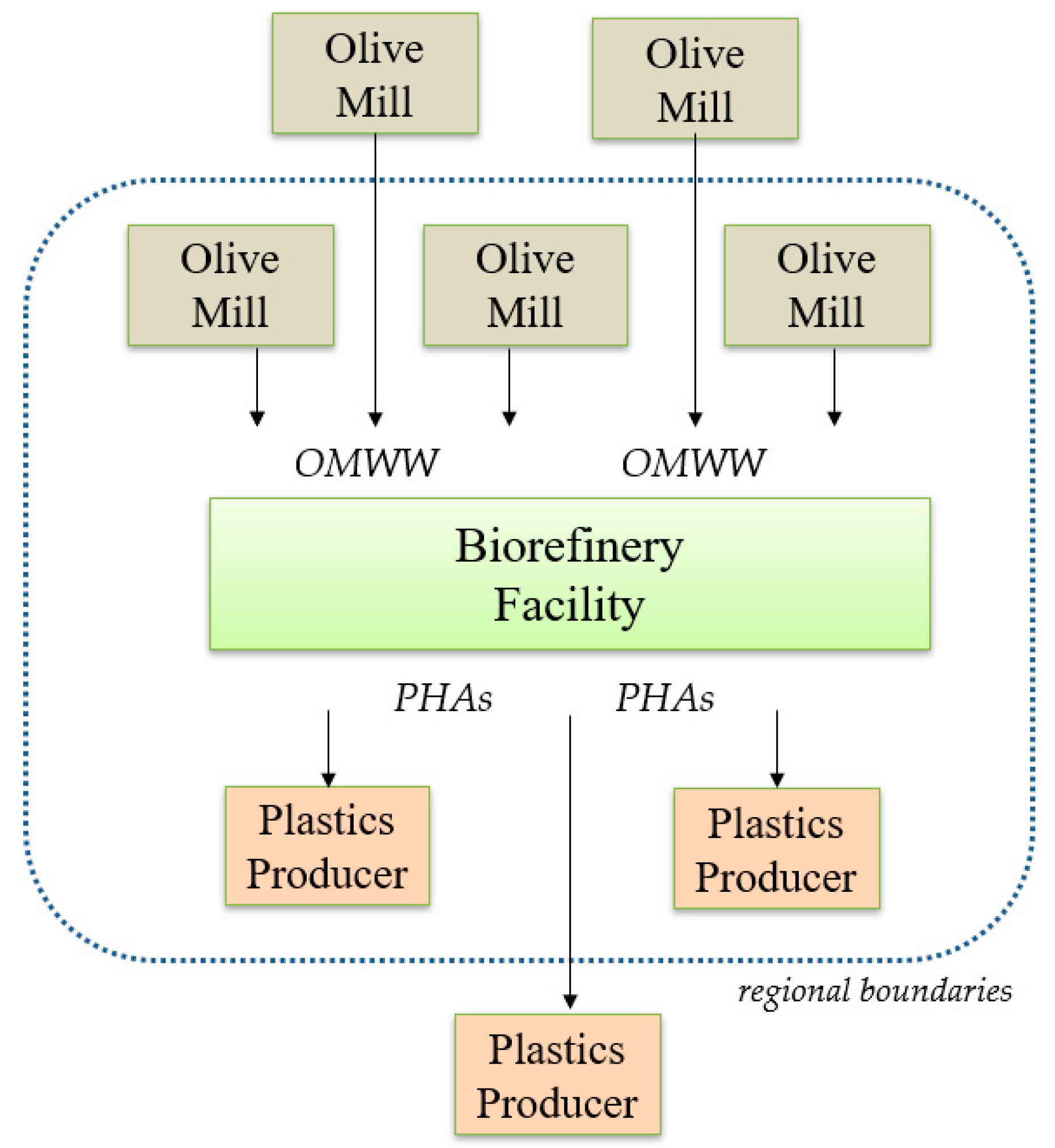
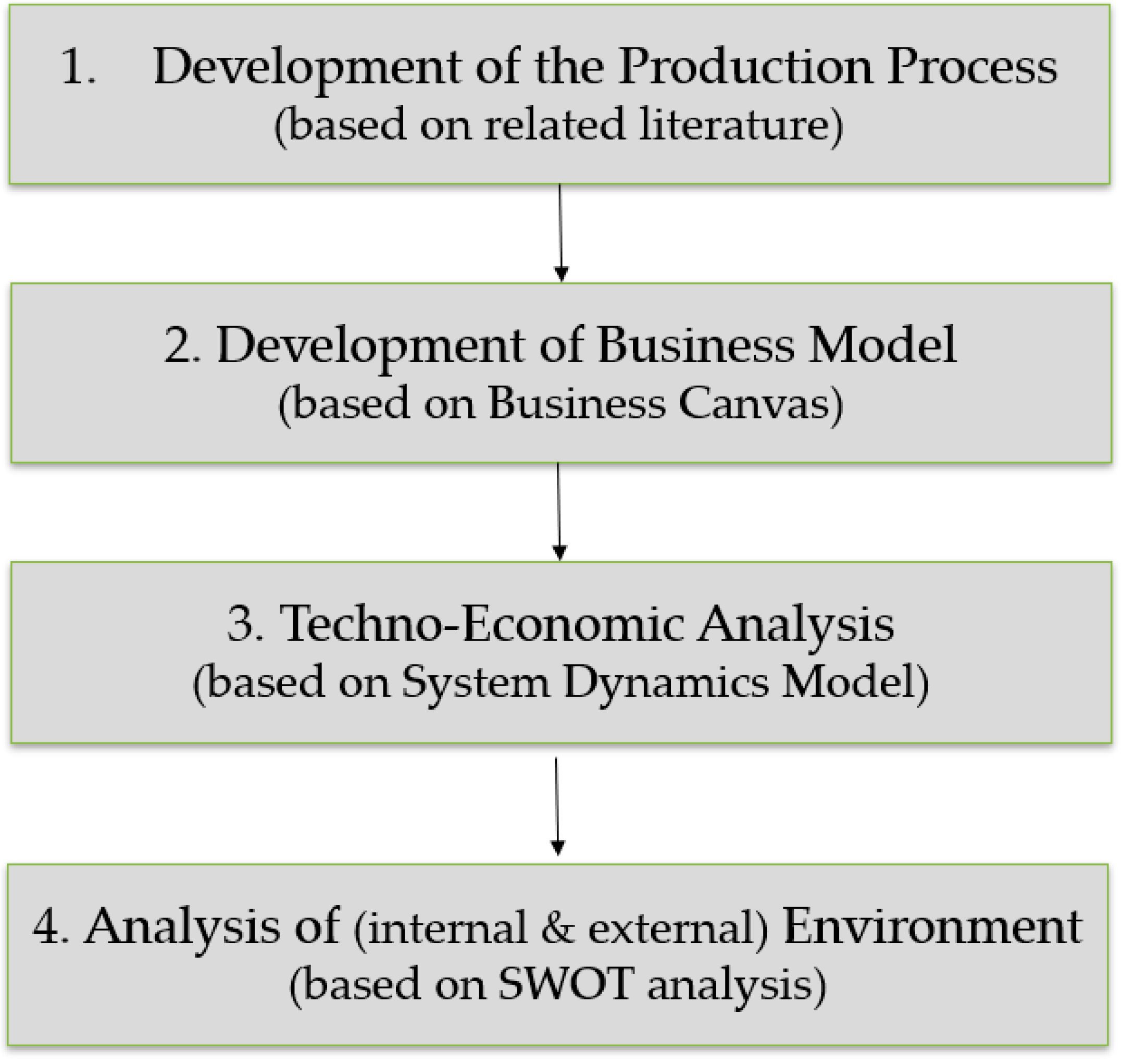
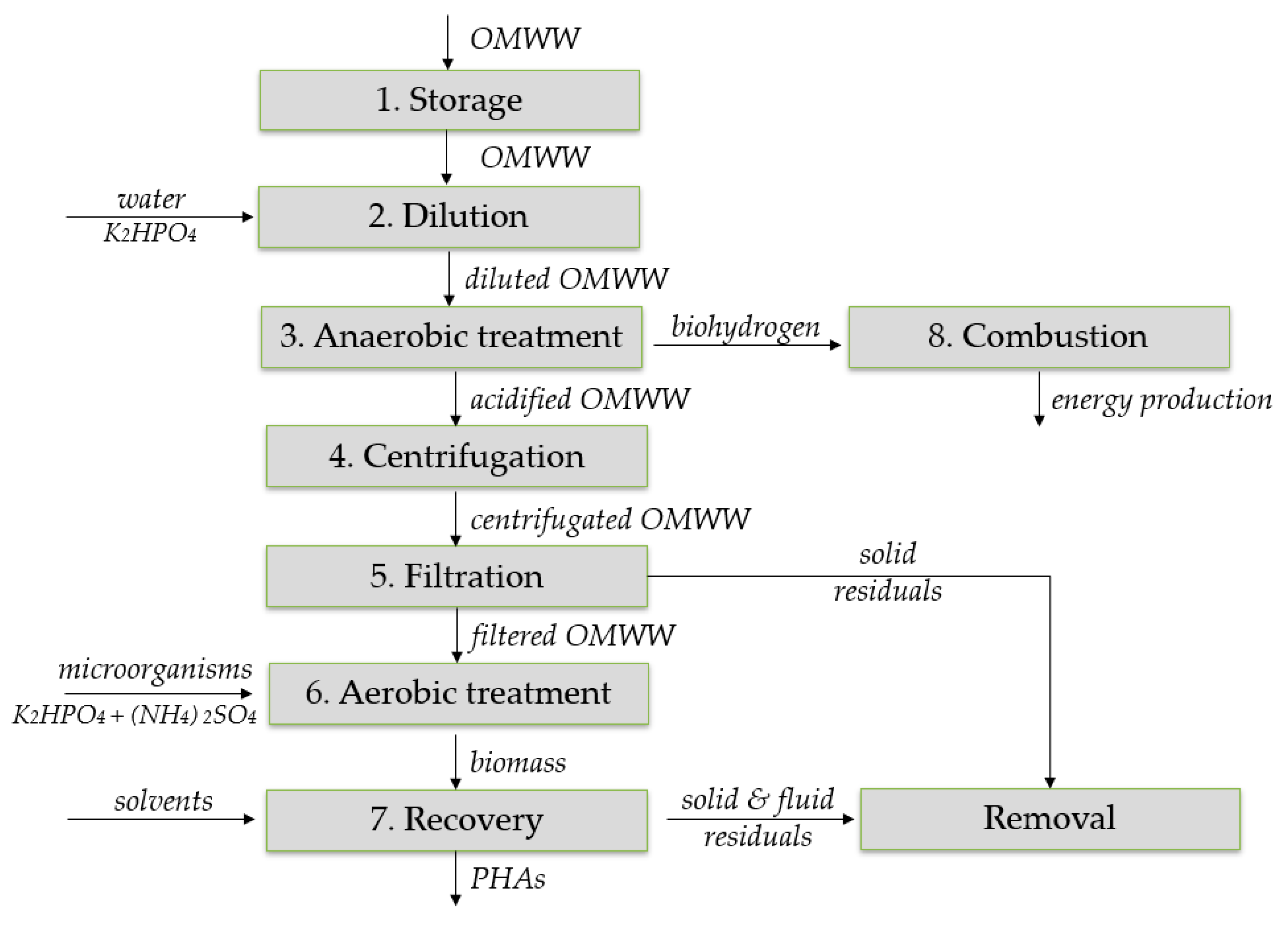
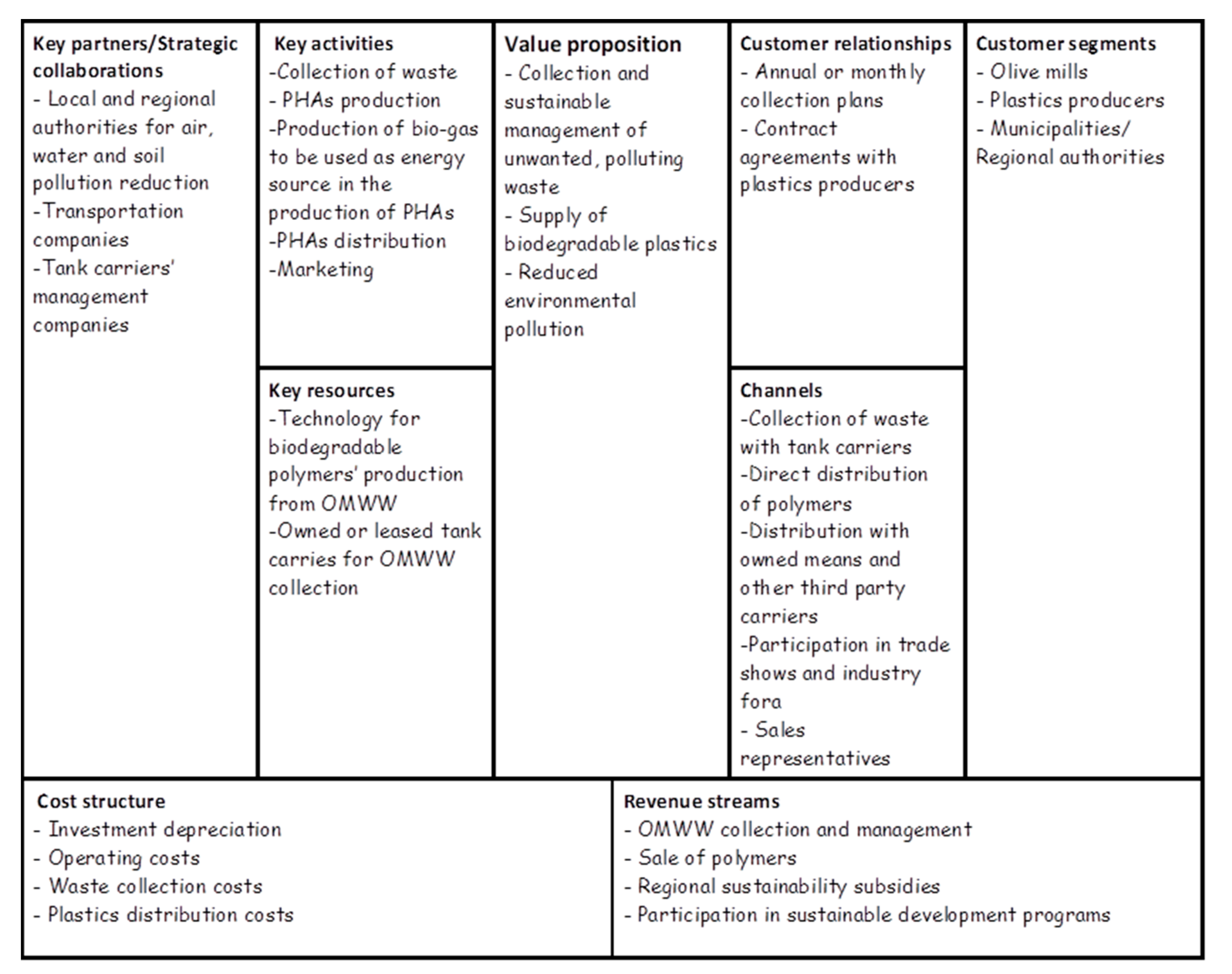
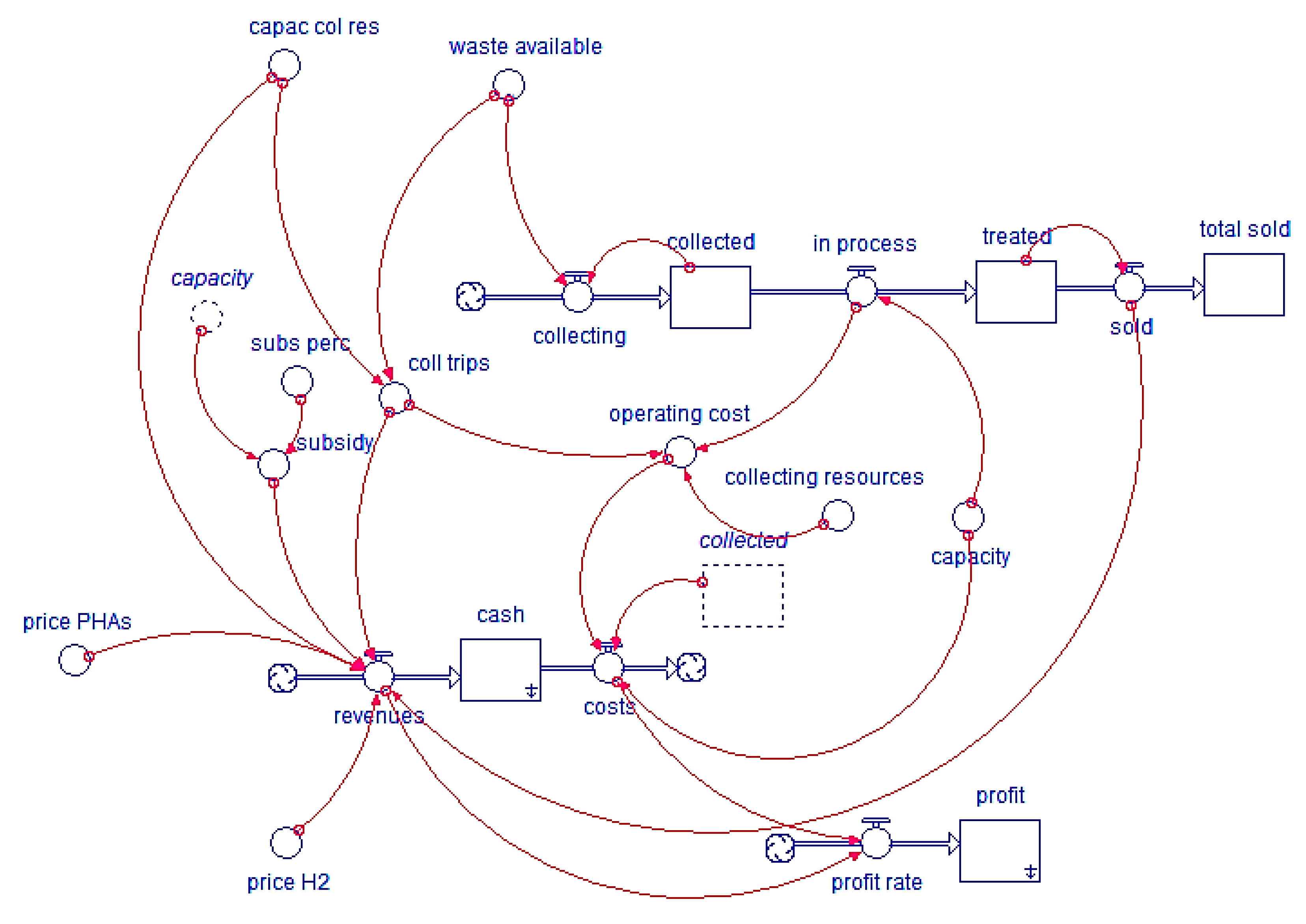
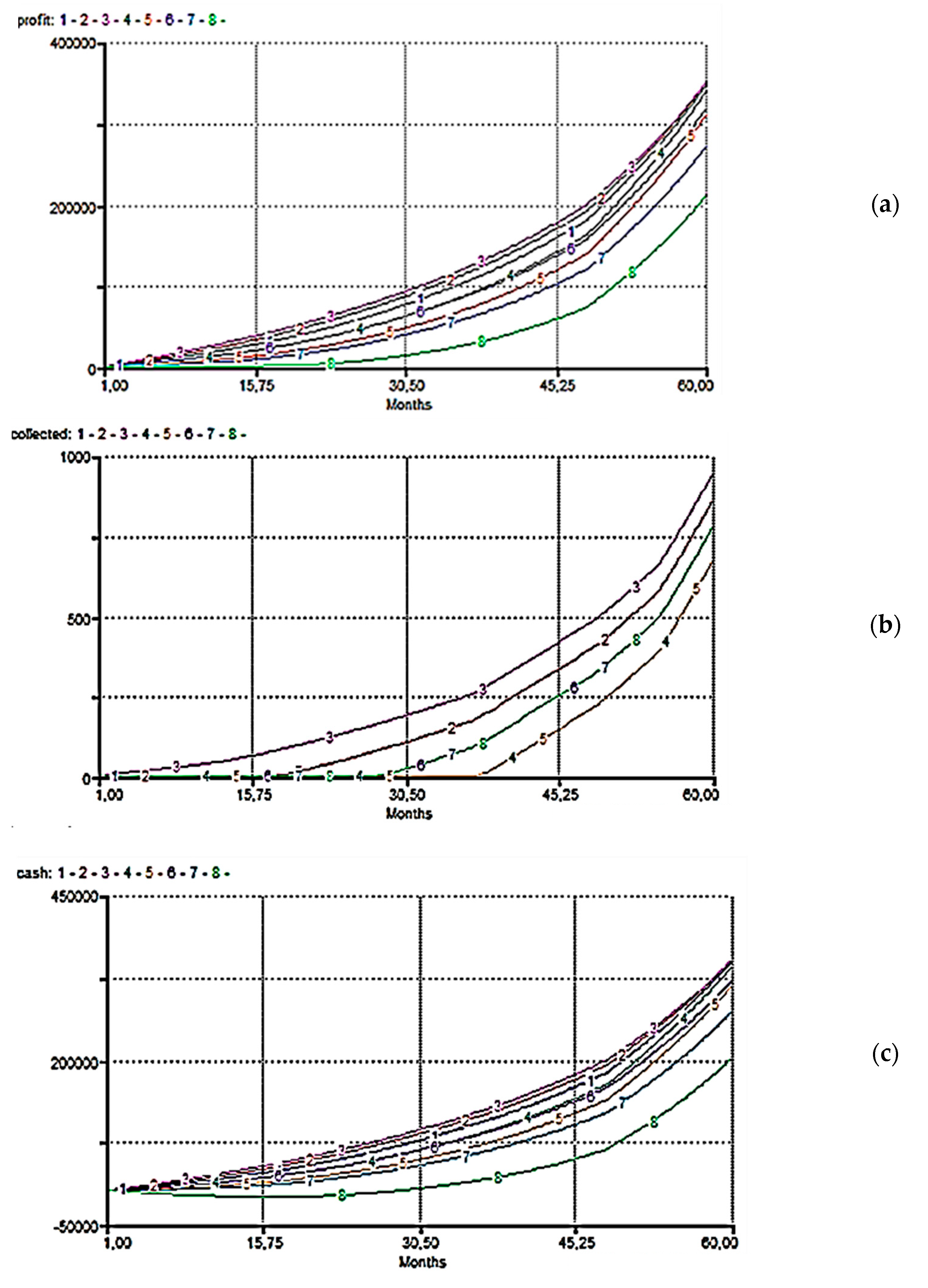
| Quantity | Properties |
|---|---|
|
|
| OMWW | PHAs |
|---|---|
|
|
| Feature | Classification |
|---|---|
| Platforms | Oil and biogas |
| Products | Material products: biopolymers (PHAs) Energy products: biogas |
| Feedstocks | Oil-based residues: OMWW (tertiary biomass) |
| Processes | Thermochemical: combustion Biochemical: anaerobic digestion, aerobic conversion, enzymatic Mechanical/physical: extraction, separation (filtering) |
| Phase | Equipment and Supplementary Materials |
|---|---|
| 1. Reception and storage | Storage tanks with cooling coats, pumps, ducts |
| 2. Dilution | Dilution tank (Water + K2HPO4) |
| 3. Anaerobic treatment | Anaerobic reactor |
| 4. Centrifugation | Centrifuge |
| 5. Filtration | Filtration filters |
| 6. Aerobic treatment | Aerobic reactor (Microorganisms + K2HPO4 + (NH4)2SO4) |
| 7. Recovery | (chemical solvents) |
| 8. Combustion | Storage tank, peristaltic pump |
| 9. Removal | Storage tank |
| Variable | Type | Description |
|---|---|---|
| waste_available | Auxiliary (graphical function) | OMWW available for processing-work load/demand per month (increases from 250 m3 to 1250 m3 per month in the 60-month period of the analysis) |
| cap_col_res | Constant | Capacity of collecting resources (default value = 20 m3) |
| coll_trips | Auxiliary | Total number of trips for collecting OMWW per month (coll_trips = waste_available/cap_col_res) |
| collecting resources | Constant | Number of collecting resources |
| operating_cost | Auxiliary | Cost of process operation (operating_cost = in_process × 3.3 + (coll_trips × 20) + collecting_resources × 500)—cost per m3 processed (3.3 Euros) was initially calculated in annual basis and then allocated monthly |
| capacity | Constant | Available process capacity (m3/month) |
| Collecting | Flow | OMWW collected per month (m3) |
| Collected | Stock | Intermediate storage of collected before being processed (incoming inventory) |
| in_process | Flow | Volume of OMWW processed per month (m3) |
| treated | Stock | Intermediate storage of treated before being sold |
| sold | Flow | Volume of treated (m3) sold per month |
| costs | Flow | Costs = operating cost + capacity depreciation cost over a specific period (no. of months) + inventory cost (collected)—calculated monthly in Euros (costs = operating_cost + (if time ≤ 48 then capacity × 4 else 0) |
| revenues | Flow | Revenues = revenues from PHAs sold (quantity × price) + revenues from collection services (150 Euros per collection trip + revenues depending on the volume collected) + revenues from selling hydrogen produced + government subsidy depending on the operational capacity and the related operational cost (all in Euros) (revenues = sold × price_PHAs + coll_trips × (150 + capac_col_res × 1.5) + price_H2 + subsidy) |
| subsidy | Auxiliary | Total subsidy based on operational capacity, operational costs, and subs_perc coefficient |
| subs perc | Constant | Percentage of operational cost subsidized |
| price_PHAs | Constant | Price of PHAs per m3 (in Euros) |
| price_H2 | Constant | Price of H2 per m3 (in Euros) |
| cash | Stock | Cash = revenues − costs |
| profit_rate | Flow | Profit rate per month (profit_rate = revenues – costs) |
| profit | Stock | Total profit in 60 months (Σ[profit_rate]) |
| Assumptions | Default Values |
|---|---|
| Cost per trip (fuel)/month = 20 Euros Cost of actual processing/m3/month = 4 Euros Cost of rent/lease of collecting resources/month = 500 Euros Inventory cost/m3/month = 3 Euros Conversion coefficient of OMWW to PHAs (volume) = 0.42 | Capacity = 1000 subs perc = 0.5 collecting_ resources = 2 |
| No. | Processing Capacity (m3) | No. of Collecting Resources (#) | Percentage of Subsidy (%) |
|---|---|---|---|
| 1 | 1000 | 2 | 0.5 |
| 2 | 800 | 2 | 0.5 |
| 3 | 600 | 2 | 0.5 |
| 4 | 1250 | 2 | 0.5 |
| 5 | 1250 | 3 | 0.5 |
| 6 | 1000 | 3 | 0.5 |
| 7 | 1000 | 3 | 0.3 |
| 8 | 1000 | 3 | ø |
| Internal Environment | External Environment |
|---|---|
| Strengths Provision of a novel service (market creation) Easy access to raw materials Environmentally sound business | Opportunities Local potential customers (plastic production ventures) Strategic collaboration with local (olive oil) cooperatives Technology acquisition from local University Tightening up and monitoring existing regulations for OMWW Campaigns for the promotion of bioplastics through national policy, and/or business strategies Available funding schemes (EU grants and national subsidies) Consumer preference for bio-based products Geographical extension of symbiosis (olive mills, and/or other ventures from adjacent regions) Valorization of similar (and locally produced) wastes (e.g., dairy industry) |
| Weaknesses Seasonality of feedstocks Feedstocks of varying quality Use of novel not sufficiently tested technology Strong dependence on local olive mills Focus on a single product | Threats Possible failure/shutdown of basic suppliers Changes in legislation (restrictions in waste transportation/treatment) Threat of new competitor(s) entering the market Economic instability and volatility in corresponding inputs and outputs prices Impact of climate change on olive tree agriculture Industry reservations towards bio-based products as raw materials |
Publisher’s Note: MDPI stays neutral with regard to jurisdictional claims in published maps and institutional affiliations. |
© 2022 by the authors. Licensee MDPI, Basel, Switzerland. This article is an open access article distributed under the terms and conditions of the Creative Commons Attribution (CC BY) license (https://creativecommons.org/licenses/by/4.0/).
Share and Cite
Mouzakitis, Y.; Adamides, E.D. Techno-Economic Assessment of an Olive Mill Wastewater (OMWW) Biorefinery in the Context of Circular Bioeconomy. Eng 2022, 3, 488-503. https://doi.org/10.3390/eng3040035
Mouzakitis Y, Adamides ED. Techno-Economic Assessment of an Olive Mill Wastewater (OMWW) Biorefinery in the Context of Circular Bioeconomy. Eng. 2022; 3(4):488-503. https://doi.org/10.3390/eng3040035
Chicago/Turabian StyleMouzakitis, Yannis, and Emmanuel D. Adamides. 2022. "Techno-Economic Assessment of an Olive Mill Wastewater (OMWW) Biorefinery in the Context of Circular Bioeconomy" Eng 3, no. 4: 488-503. https://doi.org/10.3390/eng3040035
APA StyleMouzakitis, Y., & Adamides, E. D. (2022). Techno-Economic Assessment of an Olive Mill Wastewater (OMWW) Biorefinery in the Context of Circular Bioeconomy. Eng, 3(4), 488-503. https://doi.org/10.3390/eng3040035









